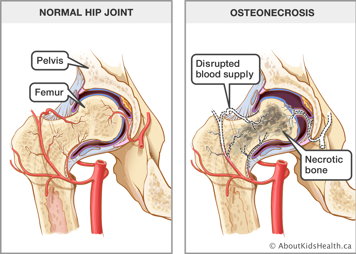Your child receives chemotherapy as part of acute lymphoblastic leukemia (ALL) treatment. Chemotherapy may also target healthy cells inside our bones. Corticosteroids, like prednisone and dexamethasone, can affect the growth of healthy bone cells.
Damage to joints
Steroids can damage the joints by interrupting the blood supply, causing a condition called osteonecrosis or avascular necrosis. When our bones do not receive enough blood, bone tissue starts to die off.
If your child complains of pain in the joints — mostly in the knees and hips — or develops a limp, contact your doctor. Although osteonecrosis usually develops within two to three years of therapy, many children can show signs during the last phase of treatment (maintenance).

Weaker bones
Steroids can also make bones weaker by causing them to become less dense. As bones get thinner, they lose important minerals such as calcium, which keeps our bones strong. The amount of minerals for every square centimeter of bone is an important measure of how strong they are. This is called bone mineral density (BMD). If your child’s BMD reduces, it increases the chance of their bones breaking (fractures).
What can be done to help maintain healthy bones?
Keeping up with regular follow-up appointments is important to detect any early signs of bone damage. Doctors check for any signs of osteonecrosis and reduced BMD. This can help in early prevention, since sometimes the doctor can see the signs before they start to worsen and interfere with your child’s mobility.
Making healthy lifestyle choices can minimize the likelihood of your child developing problems with their bones later on after treatment. Encourage your child to:
- Do weight-bearing exercises, which means that your feet and body support your body’s weight. This includes hiking, push-ups, walking, climbing stairs, and bicycling.
- Eat foods with calcium and vitamin D, which are important vitamins for bone health. This can include milk products (cheese and yogurt), fish, liver, eggs, spinach, collard greens, and baked beans. Your child can take supplements if they have trouble getting enough vitamins through diet alone.
- Avoid smoking, alcohol, and excess caffeine. These can make deficiencies in bone density worse.
If pain becomes an issue for your child, physical therapists and doctors that specialize in pain management can help. You may also wish to speak with a dietitian for individual advice.